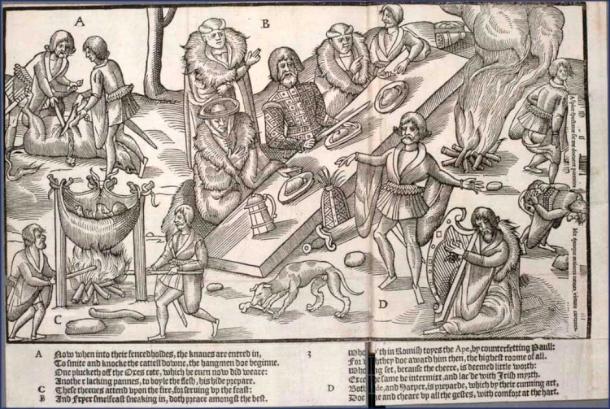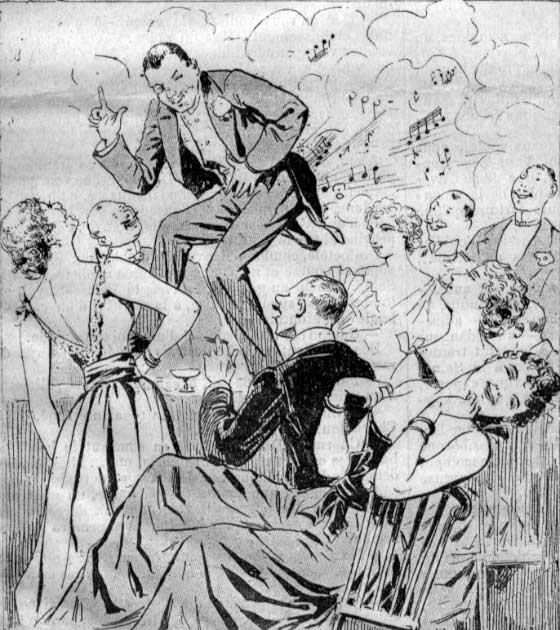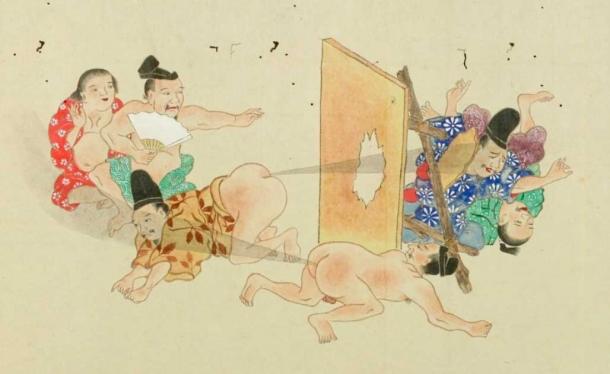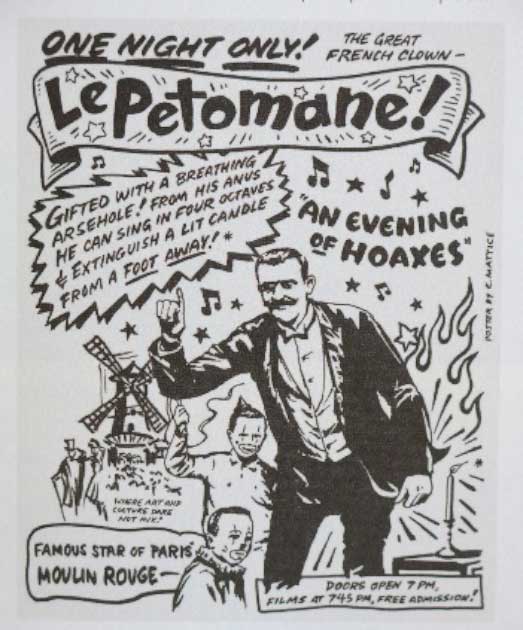
Roland the Farter: Medieval England’s Celebrity Flatulist
A manor in Suffolk and a whopping 30 acres (12 hectares) of land was given to a person who was renowned for his ability to gas, quite literally, at the behest of King Henry II. Roland le Petour, also known as Roulandus le Fartere, was granted land in the late 12th century, which was typical for favored entertainers who serviced the king. He was most probably a jester, who on special occasions like Christmas Day had to jump, whistle, and fart to entertain the assembled guests!
The historical reference can be found in the 13th century English Liber Feodorum (Book of Fees), a text that records feudal landholdings in England or lands effectively held by individuals directly from the crown. Roland’s requirement of performing ‘ saltum, siffletum, pettum’¸ (i.e., a jump, a whistle, and a fart) was well recorded. He was clearly a standard buffoon, whose fart was his stock in trade in exchange for this absolutely massive expanse of real estate and staying in Henry’s good books.
Specifically, he was granted a serjeanty, a term used to describe a form of feudal tenure, which was conditional upon rendering a specified personal service to the monarch, other than knight-service. This is how Roland was able to obtain his manor and lands, by way of serjeanty.
From the translated version of Liber Feodorum: “The serjeanty, which formerly was held by Roland the Farter in Hemingston in the county of Suffolk, for which he was obliged to perform every year on the birthday of our Lord before his master the king, one jump, and a whistle, and one fart, was alienated in accordance with these specific requirements.”
- From Fart Gods to Farting Out One’s Soul: The Historic Ritualization of Farts
- 11 of History’s Weirdest Jobs
In the 12th century, ‘Roland the Farter’ was given a Suffolk estate by King Henry II for services to comedy. His shtick was making ‘a leap, a whistle and a fart’ for the king every Xmas day. Nothing says 'Christmas' like the exertions of a skittering flatulist. #StiffUpperBrits pic.twitter.com/kqDwD9Yjr5
— Adrian Teal @[email protected] (@TealCartoons) December 24, 2018
A Scarce Historical Record, and a Deep Dive into Flatulence
However, Roland’s historical record is rather scarce, as investigated by Valerie Allen, who wrote a comprehensive historical account of Roland in her 2007 book, On Farting: Language and Laughter in the Middle Ages. Her research, based on fee ledgers, showed that Roland was possibly first working under King Henry I, and then with Henry II. By the time Henry III came along, Roland had been dismissed, with the king finding his service and talent rather “indecent”. With this, Roland had to surrender his land and manor.
It was unlikely that Roland could have actually lived the length of the reign of two kings, and reached a third’s. However, what was likely was that he was a much loved and coveted figure, and his story has been a source of much joy and amusement.
The universality of flatulence meant that no position in the social classes was exempt; everyone had the anxiety of uncontrollable wind passing out from their bodies. According to Allen, there was an added layer (pun-intended), which was one of those ‘more than meets the eye’ kind of situations.
“Gas is the product of decomposition, so morally, theologically, a lot of the writers in the Middle Ages saw it as the mark of death. There was a lot of moralization about farts and shit, that they are the living daily reminder that we are going to die and that’s all we are, we are mortal, and sinful as well,” she said.
Flatulism in Other Cultures and Histories
Surprisingly, Roland was not some historical anomaly who held this unique position in society’s annals. This profession was widespread in Ireland throughout medieval times, for example. A tradition of 8th century Irish records lists bruigedoire, or farters, as those who held retainers in courts. Roland’s contemporaries, a group of Irish farters called braigetori, allegedly occupied a table at the banquet hall of the High King of Ireland.
- A Roman Soldier’s Fart Led to the Death of 10,000 People!
- The Curious And Precarious Life Of A Medieval Jester

“The Image of Irelande”, John Derrick, 1581. Two flatulists can be seen at the right part of the picture. (Public Domain)
“Not all performing farters were land-owners,” cautions Allen, but there was an established, if not profession, at least specialty. “I should think that for festive occasions this kind of entertainment was central and necessary and must have involved high degrees of skills, a whole range of performance tricks,” she says, “They’re like circus performers.”
In Canada, in the mythology of the Innus, Matshishkapeu (literally, the Farting God) is a hugely powerful spirit. He is regarded as a legendary shaman, who can inflict gastrointestinal pain or relief upon others at will. He is even more powerful than the legendary Caribou Master, who Matshishkapeu cursed with a painful case of constipation, and had the Caribou Master beg for his forgiveness, before granting him complete relief.
Saint Augustine of Hippo (354-430 AD), too, mentioned certain performers who, in his words, had “such command of their bowels, that they can break wind continuously at will, so as to produce the effect of singing… a number of people produce at will such musical sounds from their behind (without any stink) that they seem to be singing from the region.”

According to Saint Augustine, some people could control their flatulence to the point it could resemble singing! An 1892 drawing of Le Petomane from Paris qui Rit (Laughing Paris) magazine (Public Domain)
There is even evidence of flatulist performers from the Edo period in Japan (the 1600s and the 1700s). Tokyo streets had performers called misemonos, who featured the kind of people populating ‘freak shows.’ One popular misemono star was Kirifuri-hanasaki-otoko. There is documented evidence of him from 1774, taking in quantities of air and releasing it in modulated flatulent arias. Earlier, in Japan’s Kamakura era (1185-1333), there was a popular tale of performers who performed fart dances for the aristocracy called heppiri otoko, or, farting men.

Roland the Farter was not alone; several cultures appreciated the humor of flatulence. Japanese drawing He-gassen (Fart Battle), 1864 (Public Domain)
In modern times, flatulism was brought back into fashion by Le Petomane (literally, the maniac farter) in the late 19th and early 20th century, who was a celebrity farter and entertainer in France. He developed a technique wherein he would inhale through his mouth and release it through his rectum. He could take water up his rectum and release it across long distances; he also could smoke a cigarette with his bottom, and even blow out candles.
“He dressed in a tuxedo and announced each sound as if he were presenting a music solo. Of course, the incongruence of a dignified gentleman letting farts only added to the humor,” wrote Jim Dawson, music journalist and self-titled fartologist.

Le Petomane was a French celebrity (f)artist and flatulist, rivaling the fame of Roland the Farter. An advertisement from the Moulin Rouge (Public Domain)
While flatulism has lost its popularity in recent times, there are a handful of performers still trying to keep the tradition alive, particularly with the advent of the internet and video networking sites like YouTube. However, it is fair to say that none can match the ‘airial’ prowess of Roland the Farter.
Top image: Roland the Farter’s flatulence was seemingly so impressive that it garnered a gift of land from King Henry I. Painting of The Court Jester by John Watson Nicol, 1895. Source: Public Domain
By Sahir Pandey
References
Crick, J., Houts, E.V. 2011. A Social History of England, 900-1200. Cambridge University Press. Available at: https://books.google.co.in/books?id=mM6OA8wtPOYC&dq=%22roland+the+farter%22&pg=PA405&redir_esc=y#v=onepage&q=%22roland%20the%20farter%22&f=false.
Gasper, G. December 23, 2021. Eating eels, electing bean kings and Roland the Farter: part of the medieval Christmas and New Year festivities. Available at: https://theconversation.com/eating-eels-electing-bean-kings-and-roland-the-farter-part-of-the-medieval-christmas-and-new-year-festivities-174003.
Girod, L. May 7, 2021. Roland the Farter, The Life of a Medieval Flatulist. Available at: https://historyhustle.com/roland-the-farter/.
McRobbie, L.R. December 28, 2015. The True Story of Roland the Farter, and How the Internet Killed Professional Flatulence. Available at: https://www.atlasobscura.com/articles/the-true-story-of-roland-the-farter-and-how-the-internet-killed-professional-flatulence.
Mitrica, D. July 3, 2014. Roland le Fartere – a medieval flatulist from the 12th century. Available at: https://www.zmescience.com/other/offbeat-other/roland-le-fartere-medieval-flatulist-12th-century/.
Rajan, R. July 20, 2022. The funny history of Roland the Farter. Available at: https://owlcation.com/humanities/The-Funny-History-of-Roland-the-Farter.
Rowland, R. January 25, 2022. Roland the Farter: one jump, one whistle, and one fart. Available at: https://rowlandgenealogy.com/roland-the-farter-one-jump-one-whistle-and-one-fart/.















